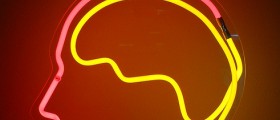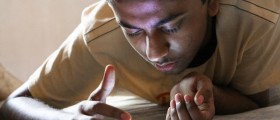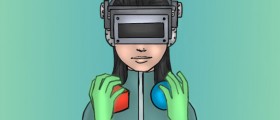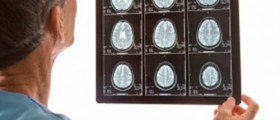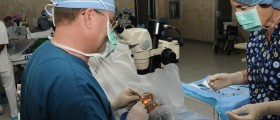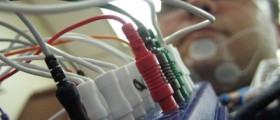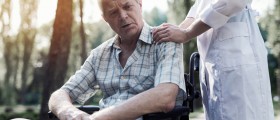My husband Jim had a thalamus stroke September 2011 where it had both eyelids closed as part of this type of stroke. On day 11 the left lid opened. The right remained closed and in the days/weeks/months following his stroke doctors suggested my focus be on his recovery if surviving and that my concern over the eye was minimal. After years of neuro-eye specialists, therapy, treatments and research I have discovered the patient who in most cases are unable to react or even realize this deficit so it falls upon the family, should take immediate action and raise the eye lids manually, gently with ones finger tip pad by softly pressing on the lid at the eyeball, raise it and if possible secure it open a bit with special therapy skin tape. If taping, it should only be for a few minutes if the eye lid is not blinking closed all the way which it must be able to do to keep the eye ball moistened. During the tape therapy, I put a eye patch on his left eye so it forces vision from the right for that time being.
When my husband is awake, the left eye is open, blinks normally, looks around where as the right eyeball is fixed towards the out side and at bit upward gaze. That right eye lid does not blink open but will appear to have the blink closed muscles working. I notice that which lets me know that cranial nerve is working.
In fact I had cranial nerve tests done on Jim to see which ones were not working after he was in an improved state of recovery and he could comprehend and cooperate in the testing process. On his case, we discovered the 3rd and 4th cranial nerves were affected by the stroke. His eye lid does not blink to open at all by itself. It stays closed like he is sleeping. His right eyeball muscles are week from this too and when we do tape therapy for 5 to 10 minutes, rarely longer, I can notice the right eyeball muscles are starting to exercise movement.
After years of research, I was informed, there is no cure. To surgically make the down eye lid open, the procedure is for permanent opening and always causes greater problems to the complete eyeball, socket and lids which warrant not even considering this as an option.
I also learned its best to have taken action right away after the stroke to start to manually move the eyelid up by my finger a few times per hour. I learned to have success in this area of injury deficits; manual action is a must right away in order for the brain to gain reconnections within the first several months. Beyond this time frame I have learned it is God alone who in His timing could make it possible for my husbands eyelid to function normally once again. This is my constant prayer and hope with a great confidence that it will one day come to light and Jim’s eyes/vision will be fully well. He also suffers from the deficit of homonymous defect (right side vision loss) so for him, his left eye allows him to see only half of that eyes vision field, only to the left side as the right side is gone.
Should you have any other questions that I may be able to help you with only based upon my own experiences please feel free to reach out to me.
God bless, Karen Nosbisch
***this post is edited by moderator *** *** private e-mails not allowed*** Please read our Terms of Use
Loading...
Loading...
My grandfather had a fall and a pretty serious brain bleed about a week ago. the first day he was very confused and out of it, but then for 2.5 days he was getting better and better eating, drinking, swallowing, was more with it. Then he did physical therapy and was doing pretty well, but then two days ago went completely down hill. Now he can't open his eyes but his pupils respond. most of the time if you talk to him he acts like he hears you and loosely can respond yes and no. he also can squeeze his hands most times and wiggle his toes.
If anyone has experience with this I would love to hear about it. thank you.
Loading...
Dad never complained about pain until about three years ago when he had severe right arm pain. We called 911 only to be assured that he didn't have a heart attack. So I brought Dad to the ER and the doctor told him that he had bloodclot in his arm and needed emergency surgery. He survived the surgery and did pretty until the doctor put him on XARELTO which caused very serious side effects. When I brought him back to the hospital, Dad was given Coumadin( Warfarin) and God gave us two more wonderful years. My parents celebrated their 70th wedding anniversary with family and friends.
During Christmas week of 2016, Dad started getting sick again and was bleeding again from the bloodthinners. During the course of a month, he received four rounds of blood transfusions.
We found out that Dad had congestive heart failure and was given LASIX which worked for awhile. He lost his appetite.
Considering his age (96), the doctor didn't want to do any potentially dangerous procedures.
He seemed to be improving so they sent him to a rehab center.
Dad was working hard at his therapy, but his oxygen dropped dangerously low and was rushed to the hospital.
Finally the doctors ordered an endoscopy to find out where the bleeding was coming from, but that procedure exhausted Dad and he was losing weight. When the nurse was giving him pain med via drops, I was wondering why because Daddy rarely complained of pain. I began to believe that he must have had another bloodclot which they could no longer treat with bloodthinners since he had already been severely bleeding from the ulcers from the bloodthinners.
Close to the time Daddy died, his eyes were shut and the only way he could respond to us was moving his toes.
I believe that Daddy must have suffered a stroke from the recent bloodclot. I am wondering if that would be a correct assumption?
Nancy
